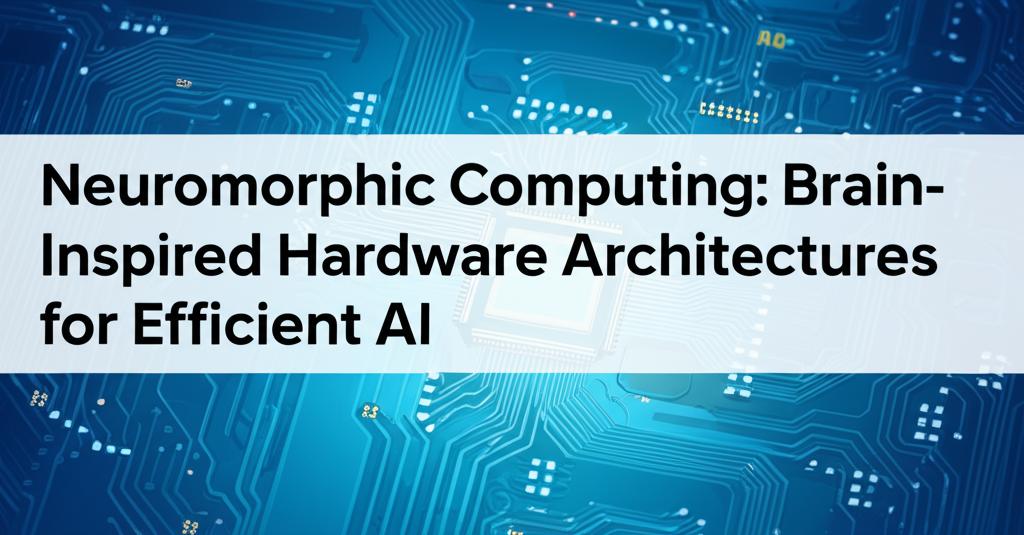Neuromorphic computing represents a significant paradigm shift, moving away from traditional computer architectures towards systems inspired by the structure and function of the human brain. This approach promises to overcome the limitations of current hardware, particularly the high energy consumption associated with training and running complex AI models, offering a path towards more efficient, adaptable, and powerful artificial intelligence.
Mimicking the Brain's BlueprintAt its core, neuromorphic computing aims to replicate the brain's efficiency by mimicking its parallel processing capabilities and integrating memory and processing units. Unlike conventional von Neumann architectures that shuttle data between separate CPU and memory units—creating bottlenecks and consuming significant power—neuromorphic systems often co-locate computation and data storage, much like biological neurons and synapses.
This brain-inspired design relies heavily on Spiking Neural Networks (SNNs). SNNs operate differently from the Artificial Neural Networks (ANNs) common in deep learning today. Instead of continuous value processing, SNNs communicate using discrete "spikes" or electrical pulses, similar to biological neurons. These networks are often event-driven, meaning computation occurs only when a spike arrives, leading to potentially massive reductions in power consumption, especially for tasks involving sparse data or requiring constant vigilance. Neurons in SNNs accumulate incoming signals over time, and only "fire" a spike when a certain threshold is reached, incorporating the element of timing into computations.
Hardware InnovationsSignificant advancements are occurring in neuromorphic hardware. Researchers and companies are developing specialized chips designed to efficiently run SNNs. Notable examples include Intel's Loihi 2 and the large-scale Hala Point system, IBM's NorthPole chip, BrainChip's Akida, and research platforms like SpiNNaker 2 and BrainScaleS 2. These chips often utilize:
- Analog, Digital, or Mixed-Signal Circuits: Implementations vary, with some using analog circuits to closely mimic neuron dynamics and others using digital circuits for precision and scalability. Mixed-signal approaches attempt to combine the benefits of both.
- Novel Materials: While many chips use traditional silicon CMOS technology, research is exploring emerging materials like memristors (memory resistors) and phase-change memory. These materials can potentially create more compact and efficient artificial synapses that change their resistance based on spike activity, enabling on-chip learning. Photonic neuromorphic circuits are also an area of investigation.
- Parallelism and Connectivity: Architectures are designed for massive parallelism, allowing many neurons to operate concurrently, and feature flexible connectivity to emulate the brain's complex synaptic networks.
The primary driver for neuromorphic computing is efficiency. Traditional AI, especially large language models, is notoriously power-hungry. Neuromorphic systems offer several advantages:
- Energy Efficiency: By processing information using energy-efficient spikes and being event-driven, these systems can potentially perform complex tasks using orders of magnitude less power than GPUs or CPUs executing conventional ANNs. This is crucial for edge computing, IoT devices, autonomous systems, and wearables where power budgets are tight.
- Real-time Processing: The inherent parallelism and low latency enable rapid processing of sensory data and real-time decision-making, vital for applications like autonomous driving, robotics, and medical monitoring devices.
- On-Chip Learning: Features like synaptic plasticity, often implemented using rules like Spike-Timing-Dependent Plasticity (STDP), allow neuromorphic systems to learn and adapt continuously from new data directly on the hardware, without needing constant retraining via the cloud.
While hardware evolves, the software and algorithms needed to program and train these systems are also advancing. Key areas include:
- SNN Training: Developing effective training methods for SNNs remains a challenge. Approaches include converting pre-trained ANNs to SNNs (though this can sometimes reduce accuracy), using surrogate gradient methods to adapt backpropagation for SNNs, and employing bio-inspired learning rules like STDP or reinforcement learning.
- Frameworks and Tools: Software frameworks like Lava, NEST, SpiNNTools, Nengo, and platforms like GeNN are emerging to help researchers simulate, develop, and deploy SNN applications on neuromorphic hardware.
Neuromorphic computing's unique capabilities make it suitable for a growing range of applications:
- Edge AI and IoT: Enabling complex AI processing directly on low-power devices like sensors, smartphones, and wearables for tasks like real-time pattern recognition, voice commands, and health monitoring.
- Robotics and Autonomous Systems: Providing fast, low-power processing for navigation, sensory fusion, and adaptive control in drones and autonomous vehicles.
- Sensory Processing: Excelling at tasks involving real-time processing of sensory data, such as image and video recognition, speech processing, and artificial retinas or cochleas.
- Healthcare: Powering real-time diagnostics, analyzing biomedical signals (like ECGs), and potentially enabling more sophisticated brain-machine interfaces.
- Scientific Computing: Simulating large-scale neural networks for neuroscience research.
- Cybersecurity: Developing advanced anomaly and threat detection systems.
Despite its promise, neuromorphic computing is still an emerging field facing several hurdles:
- Scalability: Building systems that scale to the complexity of the human brain while maintaining efficiency is a major engineering challenge.
- Accuracy and Precision: Ensuring high accuracy, especially when converting ANNs to SNNs or dealing with hardware variability (like in memristors), remains an area of active research.
- Standardization: Lack of established benchmarks, standard architectures, and software tools makes it difficult to compare performance across different platforms.
- Algorithm Development: Creating efficient algorithms that fully leverage the unique properties of neuromorphic hardware is ongoing.
- Integration: Seamlessly integrating neuromorphic systems with conventional computing infrastructure is necessary for broader adoption.
- Complexity: The field requires interdisciplinary expertise spanning neuroscience, computer science, materials science, and engineering.
The future points towards increasingly capable and scaled neuromorphic systems. Researchers envision hybrid approaches combining neuromorphic principles with traditional deep learning, and potentially even integration with quantum computing. The ultimate goal is to create AI systems that are not only powerful but also energy-efficient, adaptable, and capable of continuous learning, paving the way for truly intelligent systems deployed ubiquitously, from tiny sensors to large-scale data centers.

